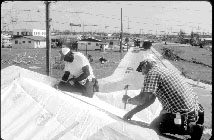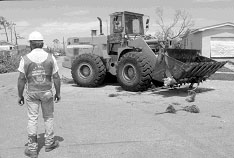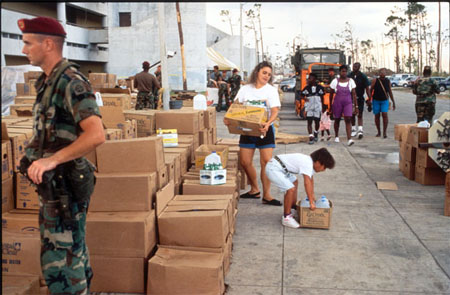In the early morning hours of Monday, 24 August 1992, Hurricane Andrew roared ashore 25 miles south of Miami, Florida, hitting Homestead and other south Dade County communities. The hurricane cut a broad path of destruction 22-miles wide, devastating the areas from Biscayne Bay to the Everglades. It leveled thousands of homes and other buildings, destroyed public utilities, ripped up trees, and left millions of cubic yards of debris. Its fierce winds tore down most of south Florida’s power lines, leaving 1.4 million customers without electricity. It was one of the worst natural disasters of the century, killing twenty people and leaving a quarter of a million people homeless. After crossing the Florida peninsula and the Gulf of Mexico, it hit southern Louisiana the next day.
The South Atlantic Division and the Jacksonville District of the Corps of Engineers responded immediately under the overall guidance of the Federal Emergency Management Agency (FEMA). During the next several months the Corps would use almost $400 million in federal funds to help south Florida recover from the devastation. The missions were varied and numerous, but a few examples show the scope and importance of the Corps’ efforts in helping civilian recovery.
| Plastic Roofing. Damaged homes needed quick temporary roof repairs. The Corps and its contractors ultimately supplied 55 million square feet of roofing material and installed it on 22,000 homes. |
|
 |
| Emergency Generators and Pumps. The Corps turned to its Prime Power units, today organized in the 249th Engineer Battalion, to provide emergency power. In addition to installing its own twelve 750-kW generators, the Prime Power units supervised the installation of generators and pumps by commercial firms. Prime Power specialists spearheaded the repair of the Dade County telephone, water, and wastewater treatment systems. |
|
 |
| Debris Removal. Massive amounts of debris blocked roads and posed health problems. The Corps began debris removal quickly. At the peak of debris removal efforts, Corps contractors and troops from the 20th Engineer Brigade operated 2,000 trucks a day. |
|
 |
| Water Supply and Distribution. Left without a safe water supply, south Floridians relied on the Corps to supply thousands of gallons of water a day until local water supplies were repaired. |
|
 |
| Temporary Housing. With thousands of south Floridians homeless, FEMA tasked the Corps to acquire property, clear debris, provide utilities, and put trailers in two large mobile home parks. Corps contractors spent $20 million establishing the parks with more than 250 travel trailers to provide temporary housing. |
|
 |
| School Repair. One important mission, which involved remarkable cooperation among agencies, was repairing damage to the schools in the devastated areas. A team of Corps personnel, contractors, Navy Seabees, Canadian military personnel, and others opened 268 of Dade County’s 278 schools on 14 September, only three weeks after Andrew had ripped through the area. |
|
 |
| Portable Toilets and Showers. The Corps supplied 5,400 portable toilets to the area under a $5 million contract and provided hundreds of shower facilities and washers and dryers. |
|
 |
Photos by Jonas Jordan, Savannah District
For more on the Corps of Engineers' emergency operations mission, see the Office of History publications Situation Desperate (Origins to 1950) and Destruction Imminent (1950 to 1979).
* * *
August 2002. No. 55.